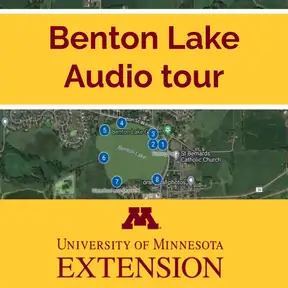Stop 7: Waterfowl and Beaver Habitats
Stop 7: Waterfowl and Beaver Habitats
As you paddle around the south side of the lake, we will soon pass areas inhabited by otters, beavers, and other fur-bearing animals. Look closely towards the shore, and you will see some trees gnawed by beavers. They cut trees using their orange teeth that grow throughout their entire lifetime. This tree chopping and construction of their dams help keep their teeth short, lest they become unusable and the beaver starves. Beavers are the second largest rodent in the world, second only to Capybaras in South America. They are mostly active at night and eat the same plants they build their houses out of.
There are also many wood duck houses here, further off the shore on the trees. Wood duck houses provide areas near water for wood ducks to live and raise their young in a safe place away from predators. The ducks usually live in tree cavities but will also live in these artificial nests as they tend to be safer. Animals like snakes, raccoons, and foxes will all prey upon wood ducks and their young but cannot get into wood duck houses raised above the ground.
Animals large and small live within the Benton Lake ecosystem. Many different species live in and around the water. For example, dragonflies, which hunt near the water during their adult life, live through their larval stage in the water. Animals such as predaceous diving beetles will hunt underwater but still live out of the water. These diving beetles can trap air around their body before diving underwater to hunt for their prey, which can be animals much larger than them including frogs and small fish. Mosquitos are also another well-known invertebrate that thrives in calm, warm water where they can lay their eggs. Taking a moment to slow down and stop paddling will allow you to see tons of insects, especially near the lake’s shore.
Benton Lake is a tale of two cities: Benton and Cologne. Benton was a village named after salesman Thomas Benton, while the Village of Cologne is named after Cologne, Germany. Although the towns were settled before the American Civil War, the annexation of Benton by Cologne didn’t occur until the 1970s. Benton now exists as a township that includes the city of Cologne. As the city grew, so did its needs. The first schoolhouse was built in 1857, and the first post office followed a few years later. Soon after, the city constructed a new church. This church stood until 1954, when a new one was erected that still stands today. St. Bernards Catholic Church, which lies just up the hill to the west of Lake Benton, was built in 1876, and a schoolhouse addition began construction in 1915. Benton Lake has existed for as long as the city of Cologne has.

